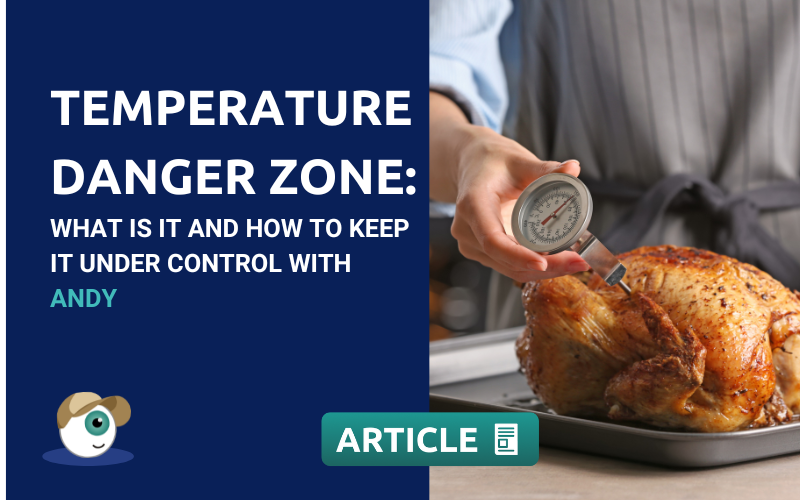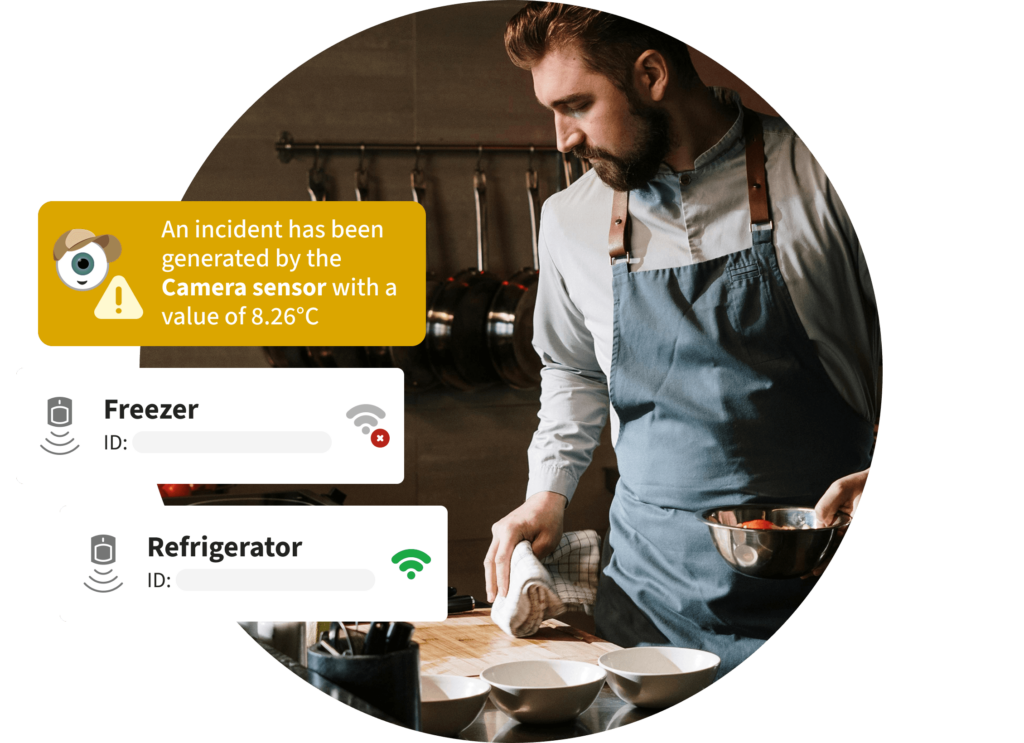Temperature Danger Zone: What It Is and How to Keep It Under Control with Andy

Wherever food is prepared, stored or served, temperature control is essential.
And you know this better than anyone.
But what happens when temperature control isn’t taken as seriously as it should be?
-
Contamination
-
Food poisoning
-
Fines
-
And a whole series of negative consequences we’d rather not get into 🙂
Food temperature is one of the main factors affecting the speed at which harmful pathogens reproduce and grow—putting at risk all the great work you and your team put into running your restaurant.
That’s why it’s vital for every member of your #team to understand how temperature impacts food safety, how to control it, and how to correctly implement food safety best practices.
Let’s dive in: what is the temperature danger zone—and how can you keep it under control?
What is the Temperature Danger Zone for Food?
The temperature danger zone is the range in which most harmful microorganisms thrive and multiply rapidly, increasing the risk of foodborne illness.
This range is generally defined as between 5°C and 60°C, where pathogens such as bacteria, moulds, yeasts, viruses, and parasites multiply fastest.
At temperatures within this range, it can take as little as 20 minutes for fast-growing bacteria like E. coli to double in number.
Of course, other factors like acidity, moisture levels, preservatives, and nutritional content also play a role in how food deteriorates.
So how do we prevent food spoilage within this critical temperature range?
By implementing proper food safety protocols that ensure food handlers regularly and systematically record food temperatures—keeping them at or below 4°C or at or above 61°C. At these temperatures, the growth of bacteria and pathogens slows or stops.
Which Foods Are Most at Risk in the Temperature Danger Zone?
So-called “high-risk foods” are especially prone to contamination and spoilage if kept within the danger zone.
These include:
-
Milk and dairy products
-
Eggs and egg-based products
-
Raw meat and meat products
-
Fish and seafood
-
Starchy foods (like cooked rice or pasta)
-
Sauces
The high nutritional content of these foods makes them an ideal breeding ground for pathogens.
What’s more, raw high-risk ingredients often contain natural microorganisms that can quickly multiply and spoil the food when stored in the danger zone.
Take unpasteurised milk, for example—it’s a perfect environment for bacterial growth, thanks to its natural microflora and nutrient richness. It can host pathogens such as Staphylococcus aureus, E. coli, Campylobacter, Listeria and Salmonella, and it can spoil within just two hours at room temperature.
The same goes for cooked meats and salads.
If stored in the temperature danger zone—or served in bulk in buffet-style warmers—they’re highly susceptible to contamination. Keeping dishes at high temperatures helps create an unfavourable environment that prevents bacterial growth.
How Long Can Food Stay in the Temperature Danger Zone??
The general rule for food left in the temperature danger zone is simple:
“Do not leave food at risk for more than 2 hours.”
To support this, here are some essential tips to keep your kitchen food-safe:
-
Plan Ahead: Avoid preparing excessive amounts of food in advance—it’s harder to keep large volumes hot or cold.
-
Monitor Your Fridge: Ensure it stays below 5°C and leave enough space for air circulation.
-
Keep Hot Food Hot: Prepared hot meals should be kept and served at above 65°C.
-
Read the Label: Follow storage instructions, especially once packaging is opened. This guide to secondary labelling will help you understand how to manage expiry dates for opened, cooked or transported foods.
-
Cool Down Quickly: Not serving food right away? Let it vent steam, portion it into smaller containers, and refrigerate or freeze. Speed up cooling under cold running water or in an ice bath. No blast chiller? Use a large bowl of ice water.
-
Transport Cold Food Properly: Always carry perishables in a cool bag. For picnics, add ice packs or frozen water bottles to keep things cold for hours.
-
When in Doubt, Throw It Out: If food has been in the danger zone for 2–4 hours, eat it immediately. After 4+ hours, dispose of it.
-
Donate or Reuse: New Spanish food waste legislation (June 2022) allows restaurants to redistribute suitable leftovers for human consumption via donation.
Too complicated?
Not really. It’s not complicated—but it does require care and consistency. And most importantly, it’s absolutely critical.
Temperature can seriously affect food safety, customer health, and your restaurant’s reputation.
So ensuring your kitchens and processes are always within safe temperature ranges isn’t a “nice-to-have”—it’s a non-negotiable requirement.
But how can you be sure your operations are consistently staying out of the danger zone?
Smart Temperature Monitoring in Your Restaurant(s)
Microorganisms spread easily from surfaces to food—or from one food to another.
A food product is considered contaminated if it contains foreign substances, harmful chemicals or living agents that can endanger the consumer’s health.
That’s why it’s so crucial to monitor your temperature zones rigorously.
1. Temperature Control Plan
Ensure your facilities and processes operate within safe temperature limits.
Set critical minimum and maximum thresholds for your equipment to prevent bacterial proliferation.
2. Staff Training
Your designated food safety manager should train and supervise staff based on their responsibilities.
3. HACCP System
Design and implement your Hazard Analysis and Critical Control Point (HACCP) plan.
Define recipes and technical sheets for each dish.
Keep comprehensive logs—record temperatures as often as required, and document incidents and corrective measures.
That’s Where Andy Comes In
Andy is the go-to digital assistant for the food service, food retail and hotel sectors.
It guides and automates the essential day-to-day tasks in your restaurant—including the time-consuming job of recording temperatures.
With Andy, you can easily carry out all your HACCP logs: temperature records, hygiene checks, goods-in inspections, and more. The platform is fully customised to your business’s unique routines.
Plus, Andy detects alerts and proposes tailored action plans in the event of issues.
Our digital food safety management system automatically generates smart monitoring forms based on your kitchen’s daily operations.
With Andy, your team will never miss a critical control point again when checking temperature danger zones.
Why trust our Digital Assistant Andy?
Because with Andy, you:
-
Eliminate human error in temperature monitoring
-
Have instant access to data—vital for internal or external audits
-
Save time your team can use on other key tasks
-
Save money by cutting waste
-
Avoid costly headaches
-
And ensure your team and customers are always protected
Want to try it for yourself?
👉🏽SIMPLY SIGN UP TODAY AND GAIN ACCESS TO OUR FREE TRIAL! 👈🏽



